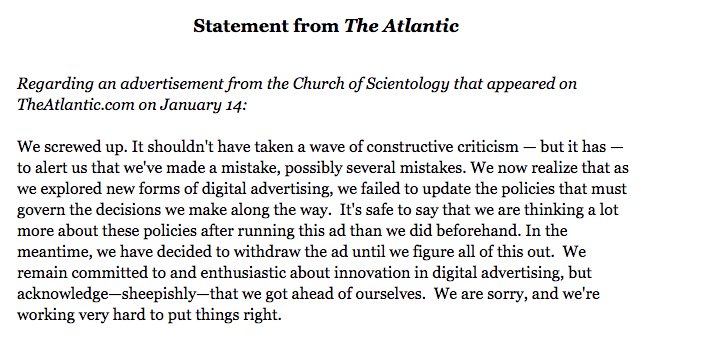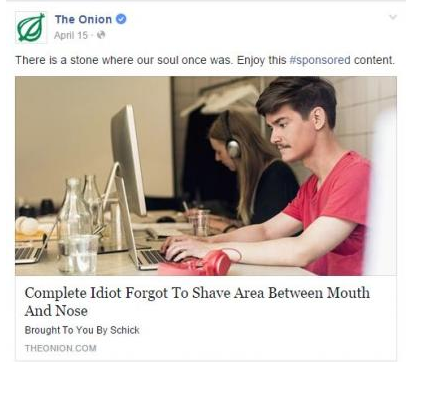How publishers can create commercial content without selling out
Readers want to connect with brands that integrate into their lives in smart and engaging ways, and publishers can do this without abandoning editorial integrity, Alexandra Tselios explains in this guest post.
One of the areas that I am committed to understanding is the complicated link between what readers want to read and how they want to be connected to a brand, by a publisher they trust.
Recently, we saw consumer outrage in the form of a grass roots campaign protesting the commercial relationship between family friendly brand Lego and The Daily Mail UK.
This partnership led to a public announcement that they will no longer engage in any further advertising. While arguments have included that Lego should not have pulled advertising from the Daily Mail due to consumer outrage, the ultimate lesson was they are a brand who wanted to be clear they were listening to their audience.
It is no longer enough for a marketing campaign to ensure only eyeballs and exposure, or even an ROI driven strategy, but also that the very commercial alignments are palatable to potential consumers while ensuring a valuable message – that is a tough balance.
The world of billboard and TV commercial advertising that aims to speak at the audience, rather than engage in a two-way conversation, is rapidly changing.
The science behind understanding reader response is everything to a publisher, seeing as many forms of sponsored content pieces can go ‘unshared’ across top-tier publishers (safe but wasted media spend) or even result in all-out consumer protests at the media and brand alliance (major damage control mode).
At the same time, publishers are trying to understand how best to commercialise through a hybrid of banner ads, sponsored content, competition drives and commercial partnerships – all without turning off already cynical readers.
In my experience, the reason why the alignment fails us is due to two major factors. The first being a mistaken partnership that does not feed into the expectations of the readers, and the second, inauthentic content masquerading as an article no one cares about.
One of the markers of a successful campaign is reader engagement, with the aim to clearly track success metrics as defined by the brand while still being of value to the audience.
Whilst tricky, it is one that can be managed when taking into consideration the focus on both the client’s messaging need and the audiences consumption needs.
As mentioned, many expensive sponsored content posts sit un-shared and un-read Australia-wide, and I believe much of that has to do with how the article or content is approached by the publisher.
I have always believed that readers want to be connected with brands that integrate into their lives in smart engaging ways, and that does not need to go against editorial integrity when done with the right companies in the right way.
Much like the Daily Mail and Lego backlash, publishers such as The Atlantic had famously come under fire for publishing sponsored content by The Church of Scientology resulting in a backlash and a public apology in attempts to stop readers from turning their backs on the publication. Along the lines of Lego being clear to their audience that they listen, The Atlantic took a similar route by making it known that they will respond and change approach if backlash associated with their sponsored content occurs.
Along the lines of Lego being clear to their audience that they listen, The Atlantic took a similar route by making it known that they will respond and change approach if backlash associated with their sponsored content occurs.
This goes beyond the reader complaining that they were misled by an article which was in the end an advertisement, or even simply an embarrassingly written advertorial palmed off, as an article.
It is not just native and sponsored articles, or the backlash of brand alignment publishers need to worry about when navigating how to avoid readers responding negatively; but also the way they communicate concerns such as pleading with readers to turn off ad-blockers.
While some publishers try to compel readers into turning off their ad-blockers, other news websites such as Times of India have banned users from ad-blockers completely. It is a fine line to navigate with readers, considering the world of excessive content consumption is upon us.
So how does a publisher and a brand mitigate the risks associated with putting their story into the world?
My own experiences and the results produced by my team have indicated it is about authentic storytelling and valuable data that is not focused on just a hard sell, but rather the opportunity to engage the reader with various touch points leaving them to feel they gained something from the content rather than just being sold at.
Similarly, many in media have applauded satirical site The Onion’s work with native content and brands and integrating humour into their content.
An often cited example is the Schick Xtreme3 sponsored article ‘Complete Idiot Forgot to Shave Area Between Nose and Mouth‘ which received phenomenal shares while also proving that consumers respond to content that enriches their online experience and provides humour, irrespective of the sales message.
 At the recent NextTechNow launch in Singapore, Krystal Choo commented that “Brands are moving towards engagement marketing. But it’s not just about content creation, or creating something that engages. I know from the conversion numbers are often very low. Even if someone recognises your brand, it doesn’t actually mean a shift to conversion.”
At the recent NextTechNow launch in Singapore, Krystal Choo commented that “Brands are moving towards engagement marketing. But it’s not just about content creation, or creating something that engages. I know from the conversion numbers are often very low. Even if someone recognises your brand, it doesn’t actually mean a shift to conversion.”
The truth in these statements indicate one of the biggest barriers in brand engagement, producing content consumers don’t want to read for the sake of engaging in content marketing.
Brands do not need to produce content manically just to play in that space, they need to produce and work with publishers who are already in tune with what readers respond to and who know what content converts.
While no one could have anticipated a petition would come to light by Daily Mail protestors, there are usually patterns in the behaviour of readers that can help form some indication on a response to commercial partnerships.
The opportunity for publishers to leverage their platforms to allow engagement opportunities between brands and readers, now has the potential to be so much more valuable than simply display advertising and awkwardly placed advertorials no one cares about.
We owe it to ourselves as an industry, to have the highest of standards applied to the native content we produce, either by an in-house creative team or by the brand, and to ensure it is done in a way that enriches consumer and brand ties rather than damages them.
Alexandra Tselios is the founder and publisher of news website The Big Smoke Australia


Alexandra – great article. Given most digital publishers survive through sponsored content and tailored packages then they owe it to themselves to deliver quality content which is authentic. And those who use humour will almost certainly always have the last laugh.
I agree fully, Alexandra. Readers are to be respected and native content should be fun, engaging, honest and fresh. Otherwise, it’s like the annoying tacky chump at the bar who bothers everyone he hits on.